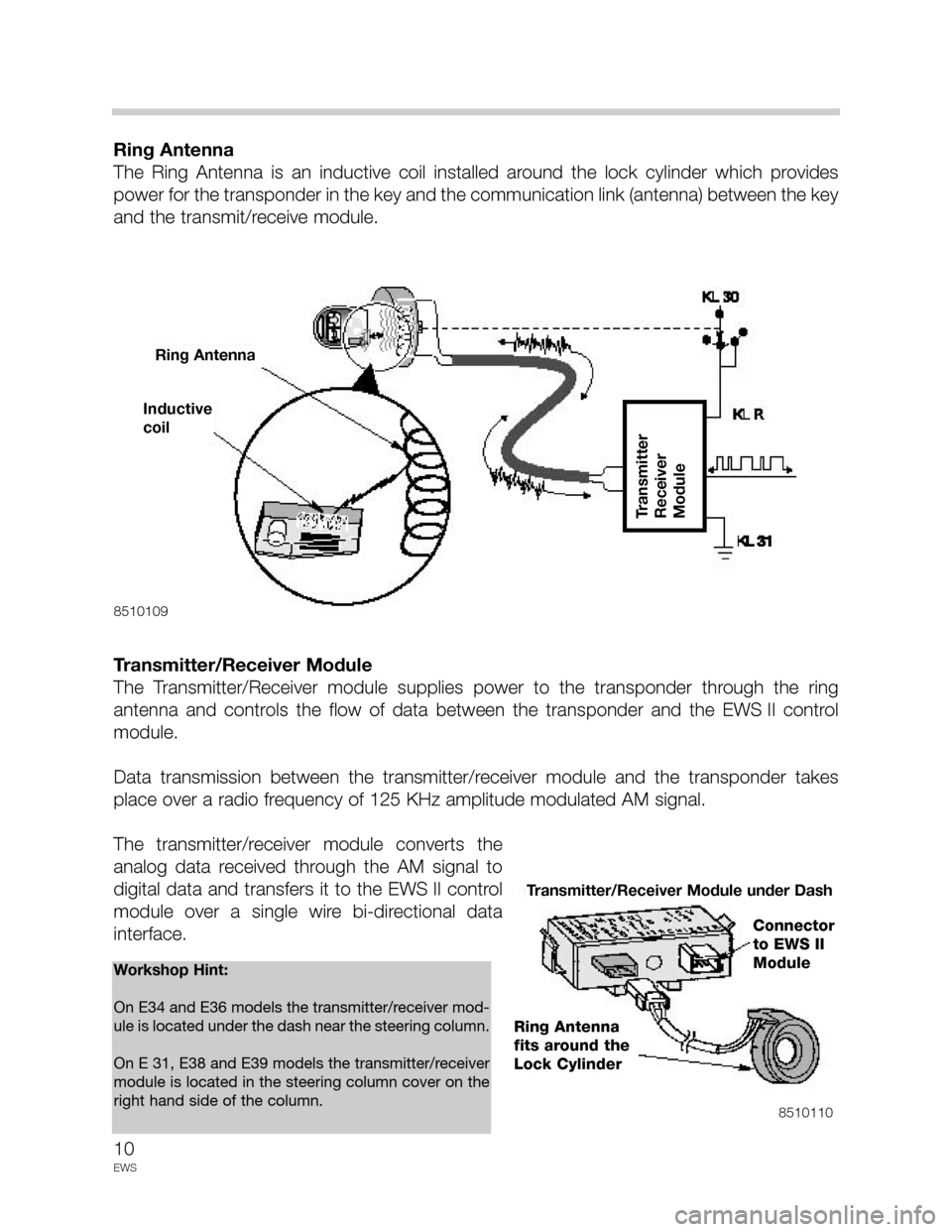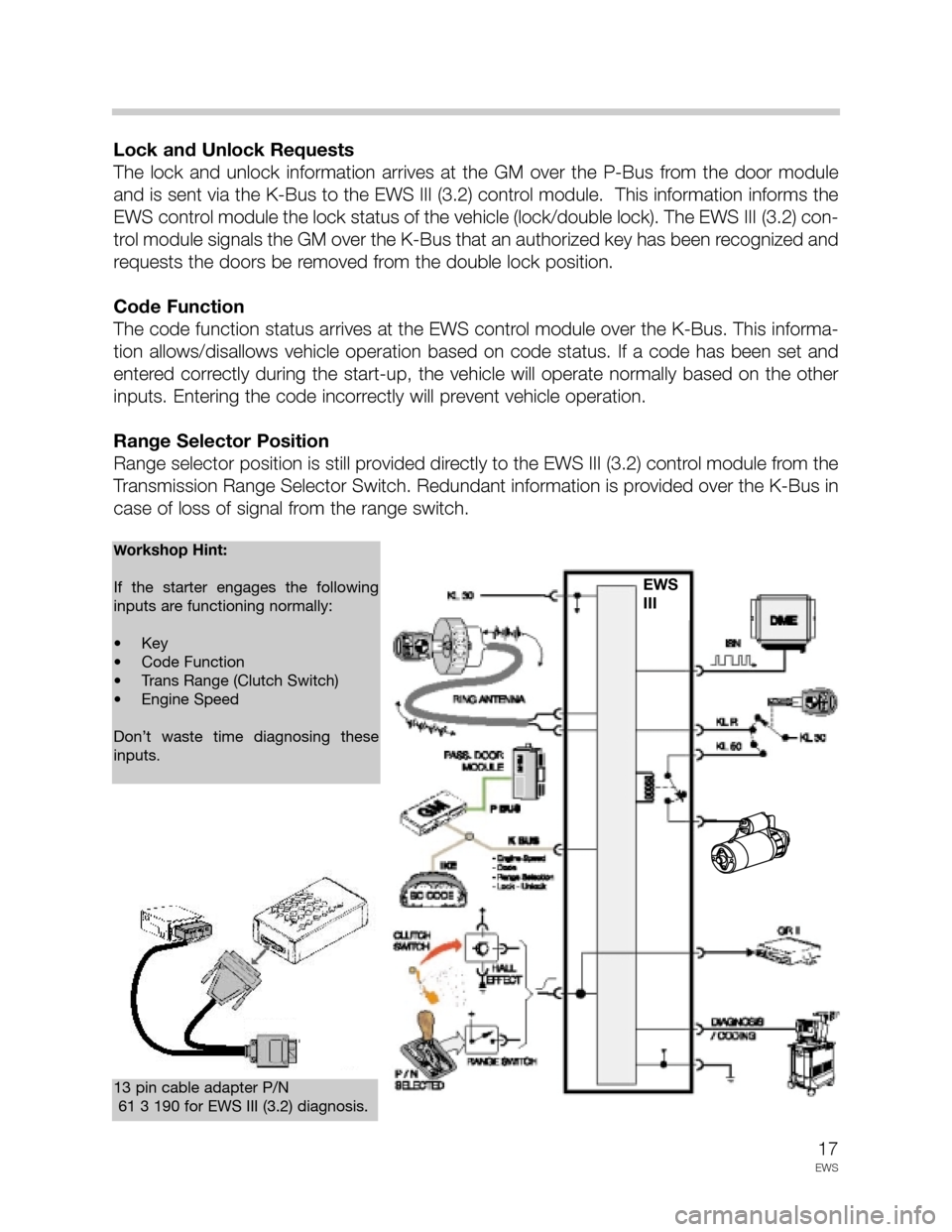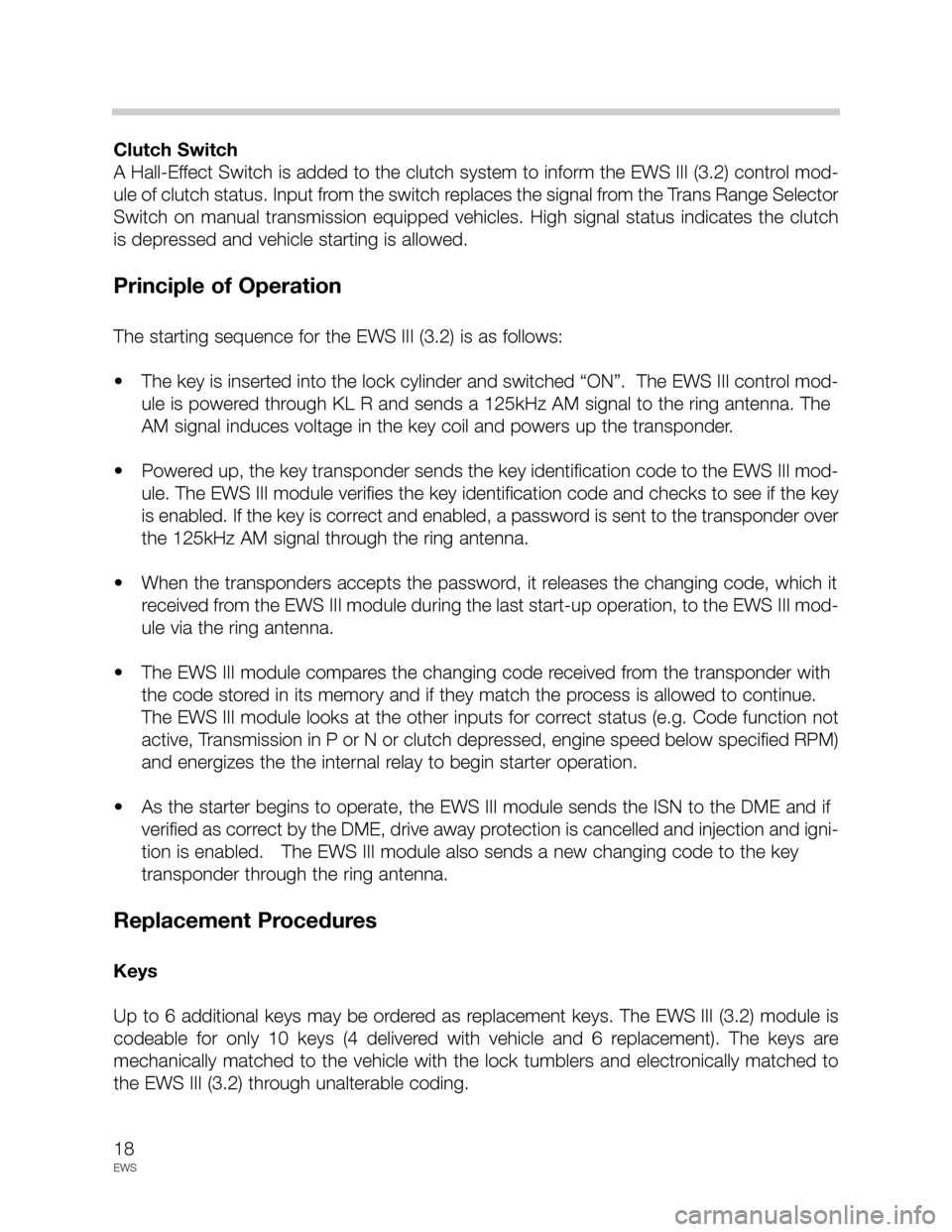2003 BMW Z8 transmission
[x] Cancel search: transmissionPage 5 of 30

5
EWS
EWS I
EWS I was installed on vehicles beginning production 1/94, replacing the original Drive
Away Protection System.
Purpose of the System
The next level of compliancy with the European Insurance Commission required additional
changes from the previous system. An additional component was added called the Starter
Immobilization Relay. This relay module provides added theft prevention and safety fea-
tures.
At the time of introduction the system was referred to as Electronic Drive Away
Protectionwhich in German is E
lectronische Wegfahrsperreor EWS.
The EWS I system consisted of the following components:
• Starter Immobilization Relay
• Door Lock Cylinders and Switch
• General Module
• Board Computer (if equipped)
• Transmission Range Switch
• DME Engine Speed Signal (Beginning 6/94 Production)
• DWA (E31)
System Components
Starter Immobilization Relay
The Starter Immobilization Relay was installed on E31, E34 and E36 vehicles.
It was in the following location:
E36 -In the relay carrier to the left of the steering column.
E31/E34-In the “A” pillar above the footwell kick panel speaker.
The Starter Immobilization Relay functions as a “Smart Relay”, a relay which receives inputs
from various sources looking at the proper combination of input signals before activating a
component, in this case the starter.
The Starter Immobilization Relay receives input from:
• Ignition Switch • General Module • Board Computer
• Trans Range Switch • DME (>6/94)
And processes output to:
• Starter • DME8510104
Page 6 of 30

6
EWS
Door Lock Cylinders and Switch
The door lock cylinders and switch input a High/Low signal into the GM informing the GM
of lock status. The signal is High when the system is in Double Lock.
General Module
The GM receives the High/Low signal from the door lock switch and outputs a High/Low
signal to the Starter Immobilization Relay. A High signal indicates the vehicle is in Double
Lock.
Board Computer
The Board Computer outputs a High/Low signal to the Starter Immobilization Relay. A High
signal indicates the Code function is active.
Transmission Range Switch
The Transmission Range Switch input with automatic transmission equipped vehicles
allows the Starter Immobilization Relay to provide a Neutral safety switch function. A High
signal from the Trans range switch indicates the transmission is in Park or Neutral. A Low
signal indicates the transmission is in a drive gear and will prevent starter operation.
DME
The DME is both an input device (after 6/94) and an output device of the Starter
Immobilization Relay.
Input
Starting with production 6/94, the DME “TD” (engine speed) signal was added to the inputs
of the Starter Immobilization Relay. This additional input allows the relay to provide a starter
protection feature. The internal relay contact (starter operation) opens if the TD signal
exceeds 60 Hz which equals the following engine speeds:
8510103
EWS I -
Starter
Immobilizer
Relay
After 6/94
Driveaway
Protection
Signal
Range
Switch
Code
Page 10 of 30

10
EWS
Ring Antenna
The Ring Antenna is an inductive coil installed around the lock cylinder which provides
power for the transponder in the key and the communication link (antenna) between the key
and the transmit/receive module.
Transmitter/Receiver Module
The Transmitter/Receiver module supplies power to the transponder through the ring
antenna and controls the flow of data between the transponder and the EWS II control
module.
Data transmission between the transmitter/receiver module and the transponder takes
place over a radio frequency of 125 KHz amplitude modulated AM signal.
The transmitter/receiver module converts the
analog data received through the AM signal to
digital data and transfers it to the EWS II control
module over a single wire bi-directional data
interface.
8510109
8510110
Workshop Hint:
On E34 and E36 models the transmitter/receiver mod-
ule is located under the dash near the steering column.
On E 31, E38 and E39 models the transmitter/receiver
module is located in the steering column cover on the
right hand side of the column.
Inductive
coil
Ring Antenna
Transmitter
Receiver
Module
Transmitter/Receiver Module under Dash
Connector
to EWS II
Module
Ring Antenna
fits around the
Lock Cylinder
Page 11 of 30

11
EWS
EWS II Control Module
The EWS II Control Module is linked to the BC, GM, DME, Trans Range switch and the
starter for drive away protection operation. The module incorporates an integral starter relay
and stores data and codes for communication with the transponder chip.
The function of the EWS II module is to provide improved drive away protection for the vehi-
cle and it incorporates many features of previous systems:
• Lock out of the starter when the code function of the BC is set.
• Disable injection and ignition through the DME.
• Prevent starter engagement with engine running.
• Recognition of Park/Neutral position with automatic transmission.
New features that have been added:
• Disable injection, ignition and starter operation until a correct key is recognized.
• EWS and DME synchronization through the use of the ISN.
• Release of double lock when a correctly coded key is switched on.
The EWS II control module stores the following data
for the key transponder inter-link:
• Key identification code- up to 10 keys.
• Key password.
• Changing code- up to 10 keys.
Workshop Hint:
On E31, E36, E38 and E39 models the
EWS II control module is located behind
the glove box in the electrical carrier.
On E34 models the module is located on
the drivers side of the vehicle behind the
knee bolster.
8510106
Typical component locations
E36 shown
Page 14 of 30

14
EWS
• If the transponder accepts the password as correct the transponder releases the
changing code (7) to the transmitter/receiver module which converts this AM signal to
digital (8) and sends it to the EWS II module (9).
• If the changing code received by the EWS II module is correct, the status of the BC,
transmission range switch and TD is examined. With correct input status the internal
starter relay is energized and the starter motor begins to operate (10). At the same
time the EWS II module sends the ISN to the DME via the single wire communication
link (11).
• If the ISN code stored in the EWS II module matches that of the DME, the drive away
protection is cancelled and injection and ignition is enabled.
• During the process of sending the ISN to the DME, the EWS II module sends a new
changing code to the transponder through the transmitter/receiver and ring antenna.
The transponder stores the changing code until
the next starting sequence.
8510122
8510124
10
11
Workshop Hints:
The entire process takes place in under 750ms.
If the starter operates, the key has been recognized as
OK and the key requires no further diagnosis. Check
status of ISN in DISplus or MoDic.
Recognition of a valid key by the EWS II module caus-
es it to send an unlock signal to the GM if the vehicle is
in double lock.
Transponder
Chip in KeyTransmitter
Receiver
Module
EWS II
EWS II
Page 15 of 30

15
EWS
Replacement Procedures
Keys
Up to 6 additional keys may be ordered as replacement keys. The EWS II control module
is codeable for only 10 keys (4 delivered with vehicle and 6 replacement).
EWS II Control Module
Replacement EWS II Control Modules must be ordered VIN specific. EWS II modules con-
tain the VIN and coding from the factory to recognize the key codes. Modules from other
vehicles will not recognize keys as being valid and not start the engine.
EWS II Control Modules store the Central Coding Key (ZCS) and the VIN. If the EWS II con-
trol module is replaced the system must be ZCS coded (SIB 61 02 96 and TRI 61 01 95).
The EWS II module must be synchronized with the DME (aligned). There is no limit to the
number of times the ISN may be changed in the EWS II module.
DME Control Module
The DME Control Module is not ordered VIN specific and must be programmed during
replacement. The ISN from the new DME must
be transferred to the EWS II module using the
DISplus or MoDic.
Key Activation
Keys that are lost or stolen may be deactivated
or made to not operate the starter functions.
The SERVICE FUNCTIONS of the DISplus or
MoDic for EWS II contains a “Bar/Release
Code” function that activates and deactivates
keys of the EWS II. Any key may be “Barred”
except the key in the ignition at the time of
deactivation. The lost or stolen key can be iden-
tified by the identification of the remaining keys.
There is no limit to the number of times a key
can be activated/deactivated.
EWS II Update
Beginning MY 1997 E31 and E36 vehicles with manual transmissions were updated to include a clutch
pedal position switch. The clutch switch signal is provided by a hall-effect sensor providing a high sig-
nal when the clutch is depressed.
Note: A “Barred” key will not start the engine, it
will still unlockthe vehicle.
Page 17 of 30

17
EWS
Lock and Unlock Requests
The lock and unlock information arrives at the GM over the P-Bus from the door module
and is sent via the K-Bus to the EWS III (3.2) control module. This information informs the
EWS control module the lock status of the vehicle (lock/double lock). The EWS III (3.2) con-
trol module signals the GM over the K-Bus that an authorized key has been recognized and
requests the doors be removed from the double lock position.
Code Function
The code function status arrives at the EWS control module over the K-Bus. This informa-
tion allows/disallows vehicle operation based on code status. If a code has been set and
entered correctly during the start-up, the vehicle will operate normally based on the other
inputs. Entering the code incorrectly will prevent vehicle operation.
Range Selector Position
Range selector position is still provided directly to the EWS III (3.2) control module from the
Transmission Range Selector Switch. Redundant information is provided over the K-Bus in
case of loss of signal from the range switch.
13 pin cable adapter P/N
61 3 190 for EWS III (3.2) diagnosis.
Workshop Hint:
If the starter engages the following
inputs are functioning normally:
• Key
• Code Function
• Trans Range (Clutch Switch)
• Engine Speed
Don’t waste time diagnosing these
inputs
.
EWS
III
Page 18 of 30

18
EWS
Clutch Switch
A Hall-Effect Switch is added to the clutch system to inform the EWS III (3.2) control mod-
ule of clutch status. Input from the switch replaces the signal from the Trans Range Selector
Switch on manual transmission equipped vehicles. High signal status indicates the clutch
is depressed and vehicle starting is allowed.
Principle of Operation
The starting sequence for the EWS III (3.2) is as follows:
• The key is inserted into the lock cylinder and switched “ON”. The EWS III control mod-
ule is powered through KL R and sends a 125kHz AM signal to the ring antenna. The
AM signal induces voltage in the key coil and powers up the transponder.
• Powered up, the key transponder sends the key identification code to the EWS III mod-
ule. The EWS III module verifies the key identification code and checks to see if the key
is enabled. If the key is correct and enabled, a password is sent to the transponder over
the 125kHz AM signal through the ring antenna.
• When the transponders accepts the password, it releases the changing code, which it
received from the EWS III module during the last start-up operation, to the EWS III mod-
ule via the ring antenna.
• The EWS III module compares the changing code received from the transponder with
the code stored in its memory and if they match the process is allowed to continue.
The EWS III module looks at the other inputs for correct status (e.g. Code function not
active, Transmission in P or N or clutch depressed, engine speed below specified RPM)
and energizes the the internal relay to begin starter operation.
• As the starter begins to operate, the EWS III module sends the ISN to the DME and if
verified as correct by the DME, drive away protection is cancelled and injection and igni-
tion is enabled. The EWS III module also sends a new changing code to the key
transponder through the ring antenna.
Replacement Procedures
Keys
Up to 6 additional keys may be ordered as replacement keys. The EWS III (3.2) module is
codeable for only 10 keys (4 delivered with vehicle and 6 replacement). The keys are
mechanically matched to the vehicle with the lock tumblers and electronically matched to
the EWS III (3.2) through unalterable coding.